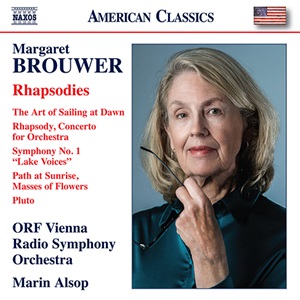
Rhapsodies
Margaret Brouwer (b. 1940)
The Art of Sailing at Dawn (2220)
Rhapsody, Concerto for Orchestra (2009 rev. 2021)
Symphony No 1, “Lake Voices” (1997)
Path at Sunrise, Masses of Flowers (2010)
Pluto (1997 version for orchestra)
Vienna Radio Symphony Orchestra/Marin Alsop
rec. 2023, Vienna, Austria
first recordings
Naxos 8.559933 [60]
This is the fourth CD in Naxos’ American Classics series devoted to the music of Margaret Brouwer. Like the others in the series, it shows her to be a versatile and eclectic composer writing in an accessible modern idiom. Her ear seems to be coloured by her years as an orchestral violinist and studies with Donald Erb and George Crumb, composers noted for their vivid approach to orchestration. The works on this disc were written over a period of twenty-five years and so give the listener a good introduction to Dr Brouwer’s style and interests.
The first work, a tone poem The Art of Sailing at Dawn, is also the most recent. It begins quietly with a hushed, almost Sibelian atmosphere, with violin glissandi imitating bird calls. The chamber orchestra is used immaculately, and one could be forgiven in thinking it was written for a larger group. Rocking figures imitate waves and various solos and one can almost feel the spray splashing against us. Hugely effective sound painting that is beautifully shaped by the conductor. My one criticism, and it may have been intentional, is that there is not a long enough gap between the quiet ending of the work and the quiet opening of the next.
The Rhapsody, Concerto for Orchestra, was written for Leonard Slatkin and the Detroit Symphony Orchestra but unhappy with the original first movement she rewrote it in 2021 which is what we have here. Regrets, Air and Rhapsodies and Dance, give the players a chance to display their abilities as an ensemble and soloists but as the word rhapsody implies there is nothing showy or unnecessarily virtuosic. The first movement has a touch of Mahler about it, tender, yet tinged with regret, the gossamer light orchestration lush in its simplicity. Air and Rhapsodies opens up the sound world with more percussion and bell like sounds. The brass play some elegant, grounded chorales while the woodwind show us the sky. In Dance, I was reminded of Peggy Glanville Hicks’ Sinfonia Pacifica with its quirky orchestration, percussion instrument ostinati to the fore emphasising the dance like rhythms.
Symphony No 1 subtitled Lake Voices was completed in 1997 is an impressive cogently expressed one movement work, with three sections, of about eighteen minutes. Dr Brouwer says she now sees it as a commentary on her own past, growing up in Dutch influenced society near the Great Lakes. It is a serious sounding work much like that other great one movement American symphony Samuel Barber’s first. The second section is rooted in Brouwer’s cultural background, with the melodic material based upon what she describes as a “Dutch hymn-like melody”. The whole work is rich in incident that builds in an inevitable way to the radiant finale, with brass writing reminiscent of Janacek’s Sinfonietta.
The tensions are relived a little in the next track Path at Sunrise, Masses of Flowers. I say ‘a little’ because there seems to be a sense of unease in the music, as though all is not right with the world. Is there something lurking in the grass? It is in any event a tightly constructed six-minute tone poem that utilises, to maximum effect, her orchestral palette of tone colours.
The disc ends with Pluto, which the composer tells us was written for the Roanoke Symphony Orchestra to follow straight on from Neptune at a performance of Holst’s The Planets. That version utilised the female chorus, but this version is purely orchestral. For me that was as misguided an idea as was Colin Mathew’s Pluto written for Kent Nagano in 2000. Now that Pluto is no longer classified as a planet, I hope conductors will leave Holst’s masterpiece alone. That said, this work is a brilliant showcase for a symphony orchestra and could easily fit in an orchestral programme in its own right. There is much to do for the percussion players early on, it being violent and full of tension. Then, halfway through, the music becomes gentler and more mysterious. Is this Pluto with Persephone? The aggressive music returns, and the work ends with a violent thwack.
Marin Alsop shows once again that she is unbeatable in this type of repertoire, and she draws some stunning playing from the Austrian players who cannot have been familiar with the music. Naxos’ American Classics Series has been invaluable in bringing lesser-known music to the fore and this is a very welcome addition to the catalogue.
Paul RW Jackson
Previous review: Göran Forsling (July 2024)
Buying this recording via a link below generates revenue for MWI and helps us keep free access to the site




















